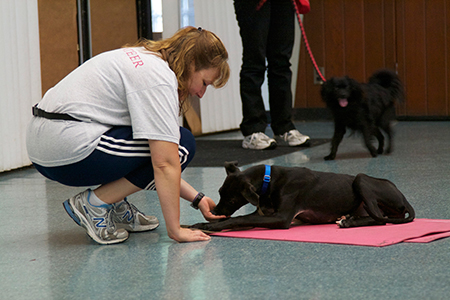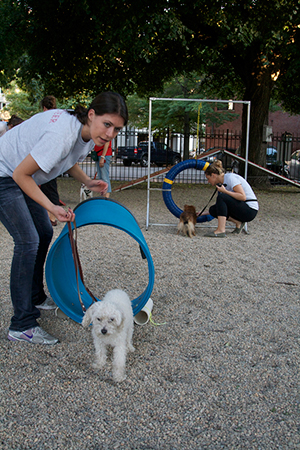Enrichment and Training for Shelter Dogs in a Shelter Dog Training Class
It’s 6:15 on a Wednesday night and there are 8 dogs and 10 people in the auditorium. There’s Tiger and Blackie who are learning sit, stay and look cues with rewards. Duke is shy and just sitting in his volunteer’s lap while being petted and loved. Brady is receiving more advanced training and going through his repertoire of tricks that include touch, spin and paw. Candy is barking and lunging at other dogs, so a barrier is set up to manage the distraction and to help her concentrate while learning. Gracie is going over jumps and building up her confidence to go through a tunnel. Lou is learning that going in a crate will get him a treat, while Lady, who is an older girl, is just surveying all of the activity as she gets some time out of her kennel. Both volunteers and employees participate in bringing these resident shelter dogs for training and much needed enrichment each week. This is a typical Wednesday night in the Shelter Dog Training Class at the Animal Rescue League of Boston.

A shelter dog training class can provide many benefits to your shelter or rescue. For starters, it enriches the dogs’ lives, as it gives them time out of a kennel, human interaction, experience in a room with other dogs on leash, and confidence while learning basic cues. It’s an opportunity for volunteers (and employees) to become more interested in the dogs as they learn about behavior and training, and all while having fun. We find that the human participants often take these experiences in the class to the street, using what they’ve learned to benefit the dogs at other times, too. Whether it’s during basic interactions or on a walk, the dogs are getting more consistency throughout the week! That same consistency can help volunteers and employees as well, providing the tools and giving them the confidence to handle dogs more effectively.
Some dogs will become less shy or more social or learn impulse control, and most will gain some basic manners from the class. It reduces stress and is an energy burn for the dogs; bodies and brains, which can result in quieter and better-behaved dogs in their kennels. The result is a dog becoming more adoptable, the greatest benefit of all.
Our Shelter Dog Training Class includes a variety of training, socialization, and fun:
- Basic cue work with sit, stay, down, look, come, paw, spin, touch, and loose leash walking
- Agility equipment work using tunnels, jumps, tires, barrels, A-frame and weave polls
- Introduction to crates and mat work
- Massage from participants, relaxation and petting
We pay careful attention to how the dogs handle the class. If a dog displays fearful or reactive behaviors, we can make adjustments to their space with barriers and distance. Alternatively, we can simply take them out of class and go for a walk. If they are removed, we will try again the next week. As they become more accustomed to the shelter and training, often within a few weeks, they’re able to come back to class.

It can be an easy project to get a shelter dog training class set up and running at your rescue or shelter. Here are some steps to help you:
- Have an employee with some dog training experience organize and teach it. If you have an employee or volunteer who is a professional trainer, they could also be asked to help run it.
- You need a space to do the training with dogs, whether outside or inside. An empty lobby or hallway when your organization is not open can work if you have no room dedicated to training.
- We make up a list of dogs who can go to the class and hang it by the volunteer board. Dogs are labeled in priority as needing time out of the kennel, observation and/or training, and whether they’re easy, medium or harder to handle.
- All volunteers are instructed to bring treats and a treat bag. We provide a few extra high value treats and clickers. The class is all positive and humane training.
- You can add extra enrichment items if you have them, like agility equipment, odd surfaces or things to help with desensitization and socialization such as canes, yoga mats, wheelchairs, cardboard and hula hoops.
- If you have puppies in the shelter, running a puppy shelter dog class is a lot fun. Have puppies play safely with each other, start to desensitize them to handling and wearing a leash, walk over odd surfaces, sniff and see agility equipment, learn to sit and meet lots of people.
After 45 minutes to an hour, the dogs and people participants walk out of the class smiling and tired. With some planning, and a little bit of work, setting up a Shelter Dog Training Class can enrich the lives of all the participants.
